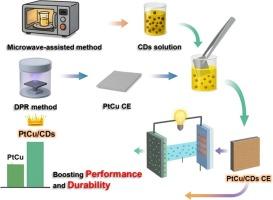Design of robust carbon dot-wrapped PtCu as an efficient counter electrode in liquid junction photovoltaic devices
IF 5.1
3区 材料科学
Q2 MATERIALS SCIENCE, COATINGS & FILMS
引用次数: 0
Abstract
This study explores a green and straightforward strategy to modify and protect counter electrodes (CEs) in dye-sensitized solar cells (DSCs). All synthesis steps, including plasma reduction, microwave treatment, and dip-coating, were designed to minimize environmental impact. PtCu-based CEs modified with carbon dots (CDs) exhibited changes in electrocatalytic performance, as suggested by CV, EIS, and Tafel analyses. The effect of CDs loading, adjusted via immersion time, on power conversion efficiency (PCE) was also evaluated. Among the DSCs examined, the highest PCE (6.21 %) was recorded for the device employing a PtCu/CDs counter electrode immersed for 40 min, although the improvement was relatively modest compared to the cell using a PtCu CE (5.83 %). The most notable finding was revealed by impedance measurements on symmetric cells before and after one week of aging. While the charge transfer resistance (Rct) of the cell using a PtCu CE increased from 39.83 to 789.4 Ω, those incorporating CDs exhibited stable or reduced Rct values. These findings suggest a potential stabilizing role of CDs at the electrode–electrolyte interface. Nonetheless, further long-term stability tests on complete DSC devices are needed to confirm this effect. This work highlights the potential of CDs for environmentally responsible CE modification in DSCs.

液体结光伏器件中高效反电极的设计
本研究探索了一种绿色和直接的策略来修改和保护染料敏化太阳能电池(dsc)中的对电极(CEs)。所有的合成步骤,包括等离子还原、微波处理和浸渍涂层,都是为了尽量减少对环境的影响而设计的。CV、EIS和Tafel分析表明,碳点修饰的ptcu基ce表现出电催化性能的变化。通过浸泡时间调整cd加载对功率转换效率(PCE)的影响也进行了评估。在所检测的dsc中,使用PtCu/CDs对电极浸泡40分钟的器件的PCE最高(6.21%),尽管与使用PtCu CE的电池(5.83%)相比,改善相对适度。最显著的发现是在衰老前后一周对对称细胞的阻抗测量。使用PtCu CE的电池的电荷转移电阻(Rct)从39.83增加到789.4 Ω,而使用cd的电池的Rct值保持稳定或降低。这些发现表明CDs在电极-电解质界面具有潜在的稳定作用。尽管如此,需要对完整的DSC设备进行进一步的长期稳定性测试来证实这一效果。这项工作强调了cd在dsc中对环境负责的CE修饰的潜力。
本文章由计算机程序翻译,如有差异,请以英文原文为准。
求助全文
约1分钟内获得全文
求助全文
来源期刊

Diamond and Related Materials
工程技术-材料科学:综合
CiteScore
6.00
自引率
14.60%
发文量
702
审稿时长
2.1 months
期刊介绍:
DRM is a leading international journal that publishes new fundamental and applied research on all forms of diamond, the integration of diamond with other advanced materials and development of technologies exploiting diamond. The synthesis, characterization and processing of single crystal diamond, polycrystalline films, nanodiamond powders and heterostructures with other advanced materials are encouraged topics for technical and review articles. In addition to diamond, the journal publishes manuscripts on the synthesis, characterization and application of other related materials including diamond-like carbons, carbon nanotubes, graphene, and boron and carbon nitrides. Articles are sought on the chemical functionalization of diamond and related materials as well as their use in electrochemistry, energy storage and conversion, chemical and biological sensing, imaging, thermal management, photonic and quantum applications, electron emission and electronic devices.
The International Conference on Diamond and Carbon Materials has evolved into the largest and most well attended forum in the field of diamond, providing a forum to showcase the latest results in the science and technology of diamond and other carbon materials such as carbon nanotubes, graphene, and diamond-like carbon. Run annually in association with Diamond and Related Materials the conference provides junior and established researchers the opportunity to exchange the latest results ranging from fundamental physical and chemical concepts to applied research focusing on the next generation carbon-based devices.
 求助内容:
求助内容: 应助结果提醒方式:
应助结果提醒方式:


